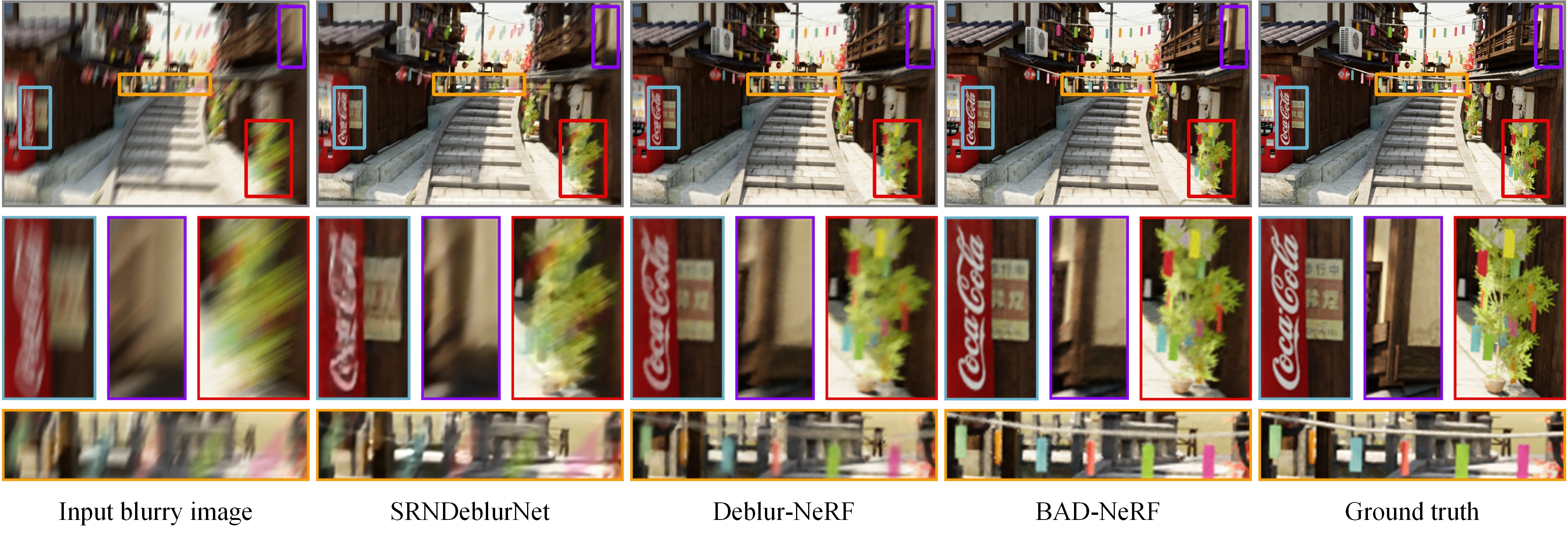This is an official PyTorch implementation of the paper BAD-NeRF: Bundle Adjusted Deblur Neural Radiance Fields (CVPR 2023). Authors: Peng Wang, Lingzhe Zhao, Ruijie Ma and Peidong Liu.
BAD-NeRF jointly learns the 3D representation and optimizes the camera motion trajectories within exposure time from blurry images and inaccurate initial poses.
Here is the Project page.
📺 [2023.12] We were invited to give an online talk on Bilibili and Wechat, hosted by 计算机视觉life. Archive of our live stream (in Chinese): [link to Bilibili]
⚡ [2023.11] We made our nerfstudio-framework-based implementation: [BAD-NeRFstudio] public. Now you can train a scene from blurry images in minutes!
demo.mp4
We follow the real physical image formation process of a motion-blurred image to synthesize blurry images from NeRF. Both NeRF and the motion trajectories are estimated by maximizing the photometric consistency between the synthesized blurry images and the real blurry images.
git clone https://github.com/WU-CVGL/BAD-NeRF
cd BAD-NeRF
pip install -r requirements.txt
You can download the data and weights here.
For the scenes of Deblur-NeRF (cozy2room, factory etc.), the folder images only includes blurry images and the folder images_1 additionally includes novel view images. But for our scenes (room-low, room-high and dark), there are no novel view images. Note that the images in the dark scene are undistorted, causing that there are some useless pixels, and you should uncomment the code of Graph.forward in nerf.py.
Change the data path and other parameters (if needed) in configs/cozy2room.txt. We use cozy2room scene as an example.
You can test our code and render sharp images with the provided weight files. To do this, you should first put the weight file under the corresponding logs folder ./logs/cozy2room-linear, and then change the parameter load_weights=True in cozy2room.txt, finally run
python test.py --config configs/cozy2room.txt
python train.py --config configs/cozy2room.txt
After training, you can get deblurred images, optimized camera poses and synthesized novel view images.
The poses (poses_bounds.npy) are generated from only blurred images (folder images) by COLMAP.
We use linear interpolation as the default spline model in our experiments, you can simply change the parameter linear (all the parameters can be changed in configs/***.txt or run_nerf.py) to False to use the higher-order spline model (i.e. cubic B-Spline).
You can change the important parameter deblur_images to a smaller/bigger value for lightly/severely blurred images.
After rebuttal, we found that sometimes the gradients will be NaN if cubic B-Spline model with a pose_lrate=1e-3 is used. Therefore, we set the initial pose learning rate to 1e-4 and it may achieve a better performance compared to that in our paper. If the gradient appears NaN in your experiments unfortunately, just kill it and try again or decrease the pose_lrate.
images: This folder is used to estimate initial camera poses from blurry images. Specifically, just put your own data in the folder images (only blurry images), and run imgs2poses.py script from the LLFF code to estimate camera poses and generate poses_bounds.npy.
images_1: This is the default training folder, which includes the same blurry images in images folder and (optional) several novel view sharp images. If you want to add novel view images (sharp images), please put them into the folder images_1 with an interval of llffhold (a parameter used for novel view testing). Remember that, set parameter novel_view to True if images_1 includes novel view images. Otherwise, if there are no novel view images, you can directly put the blurry images to the folder images_1 and set parameter novel_view to False.
images_test: To compute deblurring metrics, this folder contains ground truth images theoretically. However, you can copy the blurry images in images folder to images_test folder if you don't have ground truth images, which is the easiest way to run the code correctly (remember the computed metrics are wrong).
#-----------------------------------------------------------------------------------------#
# images folder: img_blur_*.png is the blurry image. #
#-----------------------------------------------------------------------------------------#
# images_1 folder: img_blur_*.png is the same as that in `images` and (optional) #
# img_novel_*.png is the sharp novel view image. #
#-----------------------------------------------------------------------------------------#
# images_test folder: img_test_*.png should be the ground truth image corrseponds to #
# img_blur_*.png to compute PSNR metric. Of course, you can directly put img_blur_*.png #
# to run the code if you don't have gt images (then the metrics are wrong). #
#-----------------------------------------------------------------------------------------#
images folder: (suppose 10 images)
img_blur_0.png
img_blur_1.png
.
.
.
img_blur_9.png
#-----------------------------------------------------------------------------------------#
images_1 folder: (suppose novel view images are placed with an `llffhold=5` interval.)
img_novel_0.png (optional)
img_blur_0.png
img_blur_1.png
.
img_blur_4.png
img_novel_1.png (optional)
img_blur_5.png
.
img_blur_9.png
img_novel_2.png (optional)
#-----------------------------------------------------------------------------------------#
images_test folder: (theoretically gt images, but can be other images)
img_test_0.png
img_test_1.png
.
.
.
img_test_9.png
If you find this useful, please consider citing our paper:
@InProceedings{wang2023badnerf,
author = {Wang, Peng and Zhao, Lingzhe and Ma, Ruijie and Liu, Peidong},
title = {{BAD-NeRF: Bundle Adjusted Deblur Neural Radiance Fields}},
booktitle = {Proceedings of the IEEE/CVF Conference on Computer Vision and Pattern Recognition (CVPR)},
month = {June},
year = {2023},
pages = {4170-4179}
}The overall framework, metrics computing and camera transformation are derived from nerf-pytorch, Deblur-NeRF and BARF respectively. We appreciate the effort of the contributors to these repositories.






